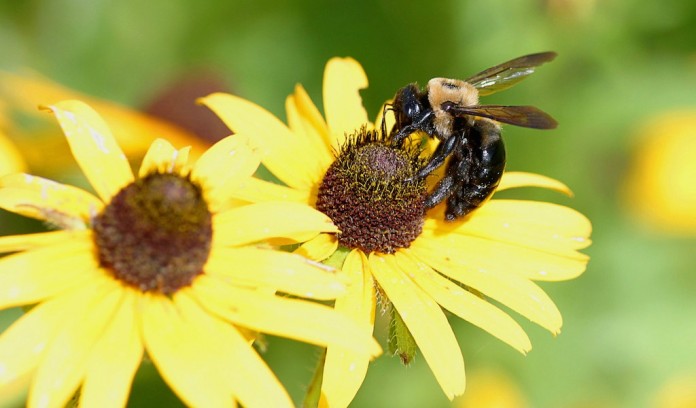SALEM, Ohio — Neonicotinoids have been a hot button topic when it comes to pollinators, particularly, bees. Ortho, a division of Scotts Miracle-Gro Co., based out of Marysville, Ohio, announced in mid-April that it will phase out neonicotinoids in its garden care lineup by 2021.
Inconclusive?
Study results on the chemical are varied, as far as the severity of its contribution to the decline of the bee population. In fact, many have concluded there is no clear link between neonicotinoids and the honey bee syndrome known as Colony Collapse Disorder (CCD).
However, Ortho brand General Manager Tim Martin said in a release, Ortho’s decision to ban the chemical is in response to a growing consumer concern over the chemicals. “This decision comes after careful consideration regarding the range of possible threats to honey bees and other pollinators,” said Martin. “While agencies in the United States are still evaluating the overall impact of neonics on pollinator populations, it’s time for Ortho to move on.”
What are neonics?
Neonicotinoid pesticides — or neonics for short — were first registered for use in the mid-1990s and have since been used widely in agricultural applications and home landscaping applications. Neonics are systemic chemicals. They are absorbed by the plant, making the plant toxic to insects. The chemicals attack the central nervous systems of insects, killing them or making them vulnerable to predators and deadly diseases, researchers say.
Home application
Ortho’s concern is with homeowner application, said Reed Johnson, bee specialist at Ohio State University. The problem is, people can use a lot more of the chemical in a homeowner setting than a commercial setting, explained Johnson. Dosages used in agricultural settings and by trained pesticide applicators are at a much smaller rate. “There is no question that those products will kill bees if applied to a flower with a bee on it,” said Johnson.
Growing concern
Concern about bee health is growing. The Maryland General Assembly passed a bill in April that would allow only certified applicators, farmers and veterinarians to apply pesticides containing neonics. “There is a campaign to blame it all on neonicotinoids and the science just doesn’t back that up,” said Dave Fisher, director of pollinator safety at Bayer CropScience.
The U.S. Environmental Protection Agency confirmed a vast majority of neonicotinoid use in agriculture is safe for bees, said Fisher. A final evaluation by the EPA is set to be released early next year, and Fisher is hopeful it will clear up the controversy over the chemical.
Wrong impression
Johnson said he is worried that by removing neonics or banning them from use, people will get the wrong impression. “The downside is, almost inevitably, if the other products are used (in place of neonics) they will kill bees too,” said Johnson. “If they can’t buy neonicotinoids, they will buy the bottle next to it instead; and it’s probably not better.”
More research
Researchers at Bayer CropScience hope continued research will help consumers to better understand that neonics are not the only threat to bees. “I feel it is unfortunate that they (Ortho) are not waiting on the scientific evidence,” said Fisher. “We stand behind these products and have tested them thoroughly.”
“However, there does need to be education and understanding on how to use these products.”
Application timing
They key for home application is timing. “Never apply an insecticides to a blooming flower, and that applies to flowers in the lawn,” said Johnson. Applying a soil drench or insecticide to a plant that is in bloom or about to be in bloom creates high concentrations of those chemicals in the nectar and pollen.
Johnson encourages people to read all labels. “Almost every question I have had (about an insecticide) is on the label. Usually, if it has bee toxicity, it has something on the label that indicates that.” Homeowners should use an insecticide only when it is necessary, he added.











First Bayer says “We stand behind these products and have tested them thoroughly.” And then they hope for research to continue which means they have not tested them thoroughly. Sounds like more delays and distractions as usual.
yeah right Bill. If you knew how many tests are done on L&G products you would be amazed.
If what you say were true we wouldn’t be having this discussion right now. These compounds were allowed for use under conditional registration that condition has not yet been met by either Bayer Cropscience or Syngenta AG. I am amazed all right!
As a beekeeper, I’m concerned about CCD, but I’m far less concerned about neonics than varroa. I’m confident that Bayer is working to produce application instructions that will minimize harm to pollinators, and, hopefully, those who apply pesticides will adhere to those recommendations. I work at the Bayer facility in Robinson, PA, and there are regular discussions about Bayer’s commitment to addressing this issue, including the building of a “bee research facility” at this site.
There is no way to safely apply these compounds even as a seed treatment they are water soluble and pervasive and highly toxic to bees. These neurotoxins have been used for two decades now and we are still waiting for application instructions come on Kevin.
Ok, Bill.
I’d rather work towards a solution.
How about a complete ban isn’t that a good solution Kevin?
A complete ban of neonics? No, I don’t think that’s a good solution, at this point.